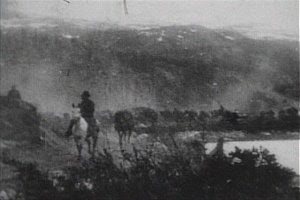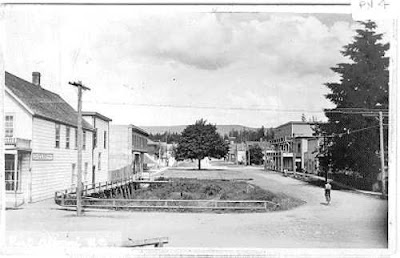
In 1898 Thomas Crahan and Robert K. Bonine, who worked for Thomas Edison came to Skagway and filmed a pack train at the Chilkoot Pass. The film shows eight loaded mules led by a man on horseback. Although it is only one minute long, filmed in summer, it is perhaps the earliest movie shot in this area. Seen above is a still from that film. Crahan went on to Dawson and did some filming there and then returned to Whitehorse to film rapids in 1900. The Klondike Exposition Company was organized by Edison and Thomas Crahan to make a filming expedition to the Yukon in order to produce films suitable for display at the Paris Exposition of 1900.
G.O.P. Headline 1921
John P. Laumister

Meet the butcher and his family who came to Skagway in the Gold Rush from Tacoma. John Laumister was born in 1850 in Germany and married Mary Ann Clark in Victoria in 1878. Their sons Charles and John Jr. were also butchers and his daughter Lillian married Mr. Black in 1930 in Alaska. Anton Laumister, probably a brother came to Skagway from San Francisco and worked as a miller and butcher also.
Mr. Laumister was in Dawson on March 8, 1917 for the big fire there:
“Fire started at 9:45 o’clock last night in the Yukonia hotel and destroyed that building and several other well known landmarks in the same block. It was 20 below zero, and the fire department made a prompt response and a fine fight was put up by the men of the brigade and by many volunteers. The fire finally was stopped after midnight and by 3 o’clock was entirely subdued. A stiff wind from the south fanned the flames from the start until the finish, and it was most fortunate that the fire was stopped as soon as it was. John Laumeister was badly burned about the head and had to have his head dressed by the surgeon at the hospital but is out and about today. James Purden was with Laumeister and his head and ears were singed. Harry Bridges, Purden and Laumeister were attempting to put out the fire in the hall with the hose when the flames drove them out and they escaped from the lobby just after the volume of heat exploded through the windows of the lobby with a great report…” from the The Daily Alaska Dispatch, Juneau on March 9, 1917.
The fire must have affected Mr. Laumister’s health because he died on this day, January 6, 1918 in St. Mary’s hospital in Whitehorse from pneumonia.
Seen above are the frozen ruins of the Yukonia Hotel following the fire.
Fairbanks news accounts; 1900 Skagway census; familysearch.
Dora Ouellet

Dora Ouellet (or Oullette or Owlette) was born during the Gold Rush, on this day, January 5, 1898 faraway in Pringle in Muskoka and Parry Sound, Ontario.
In the 1930s, Alaska Natives in the Yukon-Kuskokwim region near Bethel had the highest rate of Tuberculosis deaths and illness in the entire world. For 20 years, TB scourged the population throughout rural Alaska. By the mid-1940s, it was estimated that 10 percent of the Alaska Native population had active TB. The epidemic lasted into the early 1960s. One in 30 Natives resided in a sanitarium.
In 1945 the U.S. Health Service opened a tuberculosis sanitarium in the army hospital across the river in Skagway. Nurses came from Sisters of St. Ann in Victoria, B.C. It held as many as 90 patients before closing in 1947.
Poor Dora may have been one of the patients here because she died on July 19, 1946. A total of 56 people died in Skagway between 1945 and 1947, though not all by tuberculosis. Most of the deceased were sent back home, but a few were buried here in the Pioneer Cemetery.
Seen above is Vanilla dressed in her very best. She claims to be an Ouellet.
Skagway Death Record; Ontario 1901 and 1911 censuses.
George Johnson
George Johnson was born about 1875 probably in Alaska. He was a packer to the railroad camps along the White Pass line in 1898-1899. He was described as being half Native.
On January 2, 1899 May Burke witnessed the shooting of George by Jesse Rounds, a prostitute at White Pass City because George was harassing her.
(This location, along the White Pass route about half way to the top of the pass, is now owned by the National Park Service, but there have been no plans to do anything with the area.)
Six months later, May Burke was arrested at the Summit for “disturbing the peace”. Apparently these railroad camps were lively places.
George died on this day, January 4, 1899 and is buried in the Gold Rush Cemetery.
A wild Discouraging Mess, page 70; Skagway coroners inquest
S.S. Buford
In 1890 the S.S. Mississippi was built in Belfast as an private Atlantic Transport ship. In 1898 she was purchased by the U.S. Army for use in the Spanish American War. Renamed the S.S. Buford (after General John Buford, union cavalry hero of Gettysburg) she saw use as a troop transport ship to the Philippines, as a supply vessel in San Francisco following the great quake in 1906, famine relief missions to China, refugee and troop carrier during the Mexican Revolution and as communication hub for Galveston during the great hurricane there in 1915. In World War One she helped evacuate Americans from Europe and then transported troops. Following the war she brought home 4700 soldiers from Europe.
In 1919 she was dubbed the “Red Ark” and transported 249 “undesirables” back to Russia.
In 1921 she rescued 65 passengers and crew from the burning Tokuyo Maru near Tillamook, Oregon.
In 1923, the Buford was sold to John C. Ogden and Fred Linderman of the San Francisco-based Alaskan Siberian Navigation Company. From July 20 to September 8, 1923 the S.S. Buford sailed up from San Francisco to the Arctic. Here is a list of the ports that this aging vessel visited:
Nome, Juneau, Seward, Wrangell Island, Unalaska, Teller, Ketchikan, Pribiloff Island, Skagway, Duncan’s Bay, Swanson’s Bay, Auk Lake, Cordova, Copper River, Akutan whaling station, Dutch Harbor, Salmon Creek, Taku Glacier, Mendenhall Glacier, Spencer Glacier, Miles Glacier and Muir Glacier.
The Buford was actually commanded by Capt. Louis Lane and went 185 miles north of the Arctic Circle. At that time it was the largest ship to enter the Arctic Ocean. The Buford then went on another trip to the South Seas in early 1924.
It was then that the Buford was chartered for three months by silent movie comedian Buster Keaton for use as the principal set of his film “The Mariner” later renamed “The Navigator.” The Buford had been “discovered” by Keaton’s Technical Director Fred Gabourie while scouting for ships for another, outside project, The Sea Hawk.
Released on October 13, 1924, “The Navigator” proved to be Keaton’s most financially successful film and one of his personal favorites. An aging Captain Johnny “Dynamite” O’Brien (seen above with Keaton) partook in the filming of the movie.
After so many adventures and heroic trips, the S.S. Buford sailed on May 11, 1929 from Los Angeles to Yokaham Japan to be scrapped. If she had been a military person, she would have been decorated, but on her final voyage her only decoration was the American flag which fluttered proudly off her stern.
Wikipedia; Pacific Coastal Liners;
Frank Herbert Whiting

Born in 1857 in Mt. Pleasant Iowa, Frank Herbert Whiting came to Skagway on Friday, May 27, 1898 as Superintendent of the new White Pass & Yukon Railway. He is a background character in the Soapy shooting, having been busy on another dock unloading rails and sleepers with Mr. Graves at the time. After the shooting the Citizen’s Committee appointed the “Committee of Safety” to determine what the fate would be of the many Soapy conspirators, alleged friends and miscellaneous suspicious characters. The “Committee of Safety” consisted of eleven men. Four of these men managed transportation companies, two owned hotels, one blacksmith, two lawmen and of course the two White Pass managers, Graves and Frank Whiting. These eleven men selected the prisoners and forced them to sign over their money and agree to be handed over to the legal authorities.
Some of these men that were accused of vague crimes said that the “Committee” used their temporary and arbitrary power to get rid of business competitors in the witch hunt. Certainly in the volatile atmosphere, few Skagway residents questioned the doings of the most powerful men in Skagway. A total of fifteen men and one woman were deported but no doubt others left rather than be subjected to the “Committee” or possibly lynching.
Jeff Smith points out that when these deportees arrived in Seattle on the Steamship Tartar there is no evidence that any were ever taken into custody.
But back to Frank Whiting. He and his wife Martha and their 6 kids left Skagway in 1903. They probably returned to Denver, where they had lived before. Frank died on this day, January 3, 1936 in Seattle on a visit to his son. He was buried in Denver in the Fairmont Cemetery. One other note was that he was the great grandson of Timothy Whiting who fought in the Revolutionary War, and so was a compatriot SAR.
NPS website; Archives Canada; Alias Soapy Smith by Jeff Smith; findagrave.com; familysearch.
Kissing Cousins

Georgia Amanda Pineo and Holmes Dewolfe were born in Berwick Nova Scotia but Holmes’s family moved to Port Alberni on Vancouver Island B.C., around 1893. Holmes went to school in Victoria in 1898 and then moved to Atlin.
Holmes and his cousin Georgia fell in love and came to Skagway in 1909 to marry on June 24. The marriage did not last long though, because only a year later, on October 30, 1910 Georgia died at the age of 24. Holmes remarried in 1915 but he too died in Port Alberni, on this day, January 1, 1927 at the age of 43.
Seen above is Port Alberni about 1915 with the Pineo family hardware store on the far left.
The Register, Berwick, Kings Co., Nova Scotia.
Vital Statistics 1909; Family search

